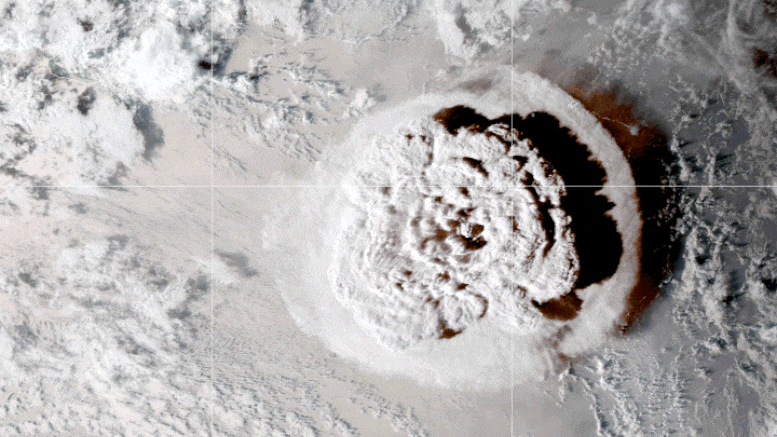
Massive Tonga Volcano Eruption Blasted Enough Water To Fill 58,000 Olympic-Size Swimming Pools Into Stratosphere
ByJet Propulsion LaboratoryAugust 3, 2022This looping video shows an umbrella cloud generated by the underwater eruption of the Hunga Tonga-Hunga Haapai volcano on Jan. 15, 2022. The GOES-17 satellite captured the series of images that also show crescent-shaped shock waves and lightning strikes. Credit: NASA Earth Observatory image by Joshua Stevens using GOES imagery courtesy of NOAA and NESDISThe unprecedented amount of water vapor hurled into the atmosphere, as detected by NASAEstablished in 1958, the National Aeronautics and Space Administration (NASA) is an independent agency of the United States Federal Government that succeeded the National Advisory Committee for Aeronautics (NACA). It is responsible for the civilian space program, as well as aeronautics and aerospace research. Its vision is "To discover and expand knowledge for the benefit of humanity." Its core values are "safety, integrity, teamwork, excellence, and inclusion."" data-gt-translate-attributes='[{"attribute":"data-cmtooltip", "format":"html"}]'>NASAs Microwave Limb Sounder, could end up warming Earths surface temporarily.On January 15, 2022, the Hunga Tonga-Hunga Haapai volcano erupted, setting off a sonic boom that circled the globe twice and unleashing a tsunami racing around the world. The underwater eruption in the South Pacific Ocean also blasted a massive plume of water vapor into Earths stratosphere. In fact, the unprecedented amount of water vapor was so enormous, that it was enough to fill more than 58,000 Olympic-size swimming pools. The sheer volume of water vapor could be enough to temporarily affect Earths global average temperature.Weve never seen anything like it, said Luis Millán, an atmospheric scientist at NASAs Jet Propulsion Laboratory in Southern California. He led a recent investigation examining the amount of water vapor that the Tonga volcano injected into the stratosphere, the layer of the atmosphere between about 8 and 33 miles (12 and 53 kilometers) above Earths surface.This satellite image shows an intact Hunga Tonga-Hunga Haapai in April 2015, years before an explosive underwater volcanic eruption obliterated most of the Polynesian island in January 2022. Credit: NASA Earth Observatory image by Jesse Allen, using Landsat data from the U.S. Geological SurveyPublished in Geophysical Research Letters, the study by Millán and his colleagues estimates that the Tonga eruption sent an incredible 146 teragrams (1 teragram equals a trillion grams) of water vapor into Earths stratosphere. Thats an amount equal to 10% of the water already present in that atmospheric layer. Thats nearly four times the amount of water vapor that scientists estimate the 1991 Mount Pinatubo eruption in the Philippines lofted into the stratosphere.Weve never seen anything like it. Luis MillánMillán analyzed data from the Microwave Limb Sounder (MLS) instrument on NASAs Aura satellite, which measures atmospheric gases, including water vapor and ozone. After the Tonga volcano erupted, the MLS team started seeing water vapor readings that were off the charts. We had to carefully inspect all the measurements in the plume to make sure they were trustworthy, said Millán.A Lasting ImpressionVolcanic eruptions rarely inject much water into the stratosphere. In the 18 years that NASA has been taking measurements, only two other eruptions the 2008 Kasatochi event in Alaska and the 2015 Calbuco eruption in Chile sent appreciable amounts of water vapor to such high altitudes. But those were mere blips compared to the Tonga event, and the water vapor from both previous eruptions dissipated quickly. The excess water vapor injected by the Tonga volcano, on the other hand, could remain in the stratosphere for several years.An image from January 16, 2022, shows the ash plume from the Hunga Tonga-Hunga Haapai volcanic eruption that occurred the day before. An astronaut took a photograph of the plume from the International Space Station. Credit: NASAThis extra water vapor could influence atmospheric chemistry, boosting certain chemical reactions that could temporarily worsen the depletion of the ozone layer. It could also influence surface temperatures. Massive volcanic eruptions like Krakatoa and Mount Pinatubo typically cool Earths surface by ejecting gases, dust, and ash that reflect sunlight back into space. In contrast, the Tonga volcano didnt inject large amounts of aerosols into the stratosphere, and the huge amounts of water vapor from the eruption may have a small, temporary warming effect, since water vapor traps heat. The effect would dissipate when the extra water vapor cycles out of the stratosphere and would not be enough to noticeably exacerbate climate change effects.The sheer amount of water injected into the stratosphere was likely only possible because the underwater volcanos caldera a basin-shaped depression usually formed after magma erupts or drains from a shallow chamber beneath the volcano was at just the right depth in the ocean: about 490 feet (150 meters) down. Any shallower, and there wouldnt have been enough seawater superheated by the erupting magma to account for the stratospheric water vapor values Millán and his colleagues saw. Any deeper, and the immense pressures in the oceans depths could have muted the eruption.The MLS instrument was well situated to detect this water vapor plume because it observes natural microwave signals emitted from Earths atmosphere. Measuring these signals enables MLS to see through obstacles like ash clouds that can blind other instruments measuring water vapor in the stratosphere. MLS was the only instrument with dense enough coverage to capture the water vapor plume as it happened, and the only one that wasnt affected by the ash that the volcano released, said Millán.Reference: The Hunga Tonga-Hunga Haapai Hydration of the Stratosphere by L. Millán, M. L. Santee, A. Lambert, N. J. Livesey, F. Werner, M. J. Schwartz, H. C. Pumphrey, G. L. Manney, Y. Wang, H. Su, L. Wu, W. G. Read and L. Froidevaux, 1 July 2022, Geophysical Research Letters.DOI: 10.1029/2022GL099381The MLS instrument was designed and built by JPL
……Read full article on SciTechDaily
Natural Disaster
Comments
Leave a comment in Nestia App